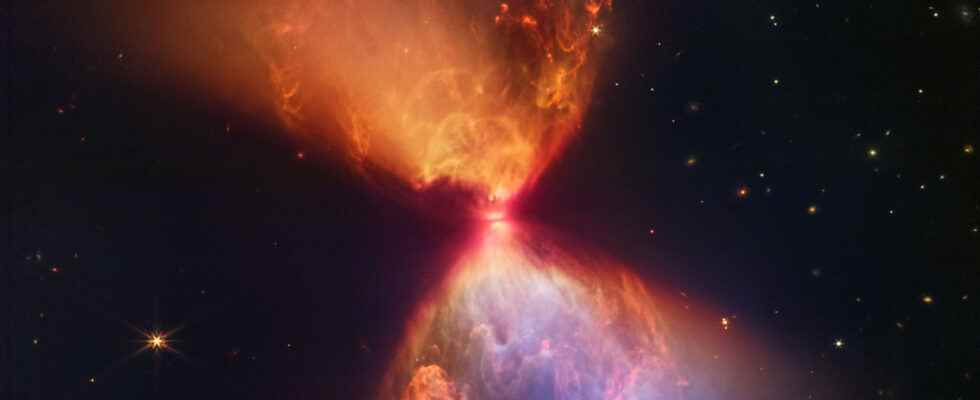A fledgling protostar, detected in 2012, reveals its details thanks to a spectacular shot by James Webb.
On the surface, it looks like a kind of cosmic hourglass. Instead of sand, it looks like interstellar gas patiently flowing through a tiny point of light. It’s an illusion: it’s not an instrument for measuring time. This image shows a star being formed. A star in the making. A protostar. Her name ? L1527.
This photograph was presented Nov. 16 by NASA — which had a busy day with the long-awaited maiden flight of the Space Launch System (SLS), marking the official start of the Artemis program and the return of astronauts to the Moon . It was captured by the James Webb Space Telescope with its NIRCam infrared camera.
In the center of the hourglass, the star in gestation. If we look carefully, we note that the star seems crossed by a horizontal black line. This dark line is not a characteristic of a proto-star, but the sign of another birth: that of a proto-planet. It is in fact a segment of the disc of matter which is forming around the star.
A protostar that is only 100,000 years old
It’s even an extremely young protostar — its age is estimated at around 100,000 years (and it’s very young on the scale of the Universe). In the classification of protostars, it falls into the so-called class 0, the earliest stage of star formation. This classification is established on the observations concerning the luminosity of the star, but also the “chaos” all around it.
All around precisely, there is gas, including in the dark portions around L1527. The more red and orange the color, the higher the dust density. But the more the chromatic range goes towards the blue, the more the dust is fine and spaced out. We guess it by admiring the variations of colors: the distribution is not quite homogeneous.
An obvious question then arises: why doesn’t the star light up everywhere, including the dark areas?
It is precisely because of the disc of matter which has a masking effect and blocks the light of the star. As a result, the gas is only illuminated where the disc does not obstruct, that is to say “top” and “bottom”. It’s a bit like a flashlight: the cone of light only goes in one direction (the others being “blocked” by the hull and the components of the device).

And this protoplanetary disk is far from tiny. The American space agency specifies that it has the size of our Solar System, the length of which amounts to tens of billions of kilometers. But from where you are, it all seems infinitesimal: L1527 is about 450 light-years from Earth, in the constellation of Taurus.
Despite the huge gap that separates us from the star, astronomers are able to say that L1527, discovered in 2012, ” does not yet produce its own energy by nuclear fusion of hydrogen », like a normal star. Its shape is not completely spherical, but also ” unstable “. As for its mass, it is between 20 and 40% of that of the Sun.
This mass gain is precisely in progress – this is what the gas clusters all around show. All the surrounding stellar dust is gradually drawn towards the center, where the protostar is. This has the effect of feeding the star, allowing it to grow, to compress and to reach the threshold of equilibrium between its gravitational mass and the triggering of nuclear fusion.
This is a phase that will be extremely long on our scale. L1527 will not be a star in its own right with tens and hundreds of thousands of years. But for astronomers, it’s a great opportunity to have a case that can tell us about the formation of stars, planets and solar systems. Like ours.
